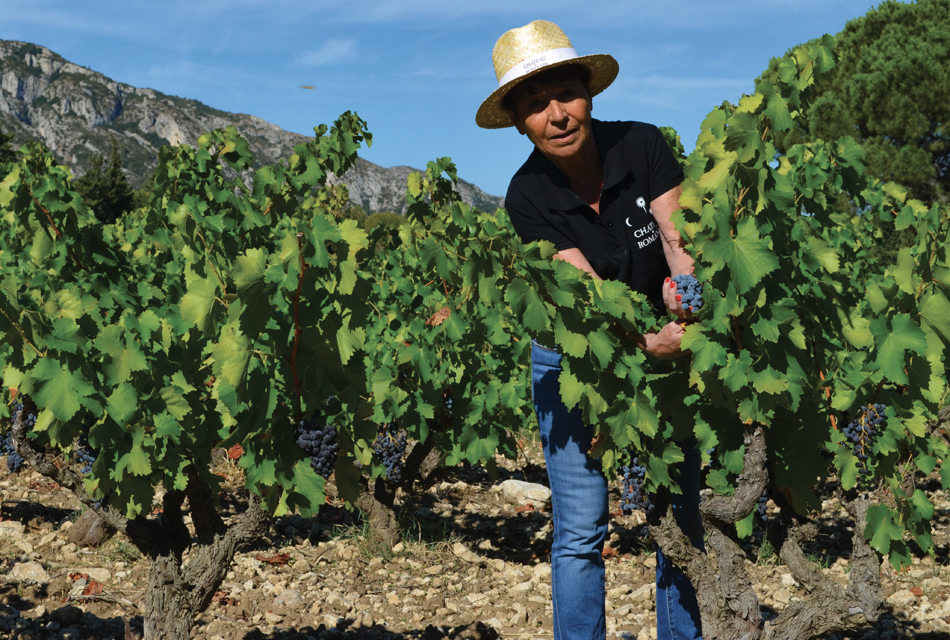
Mrs. Brigitte San-Quirce, please introduce us to Château Romanin in a few words.
This place has a rich history dating back to the construction of its castle in the 13th century. In more recent history, during the 1990s, the construction of its cathedral-like cellar took place, founded on a highly magnetic site, a true architectural feat. Finally, thanks to its diverse terroir and its north-facing exposure, not to mention the location within the heart of the Alpilles Natural Park. In my opinion, this estate is a gem that deserves to be celebrated.
Provence wines are renowned for their rosés, yet you produce 50% red wines. Is this a deliberate choice to distinguish yourselves?
Château Romanin has always produced more red wines than rosés, particularly focusing on high-quality red wines suitable for ageing. This characteristic is not unique to Château Romanin but is shared by the entire AOP Les Baux-de-Provence, which produces an average of 50% red wines, 35% rosés, and 15% whites.
The vineyard has been practicing biodynamics since 1988, certified Demeter for red wines and Biodyvin for all three colors. What practices have you implemented to preserve the environment?
Beyond the biodynamic farming practices, we are committed to creating a genuine haven of nature and biodiversity within the Alpilles Regional Natural Park. To achieve this, we plant hedges with trees and shrubs of native species from local nurseries. We collaborate with beekeepers and farmers, allowing them to use our land to promote biodiversity and have a positive impact on local fauna and flora. We also collaborate with the regional park, installing nesting boxes to encourage the presence of species like the roller. We have reintroduced horse-drawn soil cultivation, working on some hectares since 2020. Lastly, the property comprises approximately 50 hectares of vineyards and 5 hectares of olive trees, totaling 250 hectares. The remaining unplanted areas (about 200 hectares) consist of woods, forests, or rocks and are intended to remain as a biodiversity space.
Mr. Buravand, tell us about the terroir of Château Romanin and its impact on the character of the wines.
We can note three significant aspects regarding the characterization of Château Romanin's terroir. There is a great diversity of terroirs, providing us the opportunity to express a multitude of different characteristics. The elements we will detail help understand the framework of the estate's wines. We can mention the significant presence of sandy terroirs mixed with limestone scree from the Alpilles. The sand allows us to produce wines with finesse, both aromatically and tannically. Limestone brings a mineral aspect with toasted notes. The orientation of the vines, all located to the north and against the Alpilles, gives us the double advantage of benefiting from the freshness due to the exposure and the Mistral wind. The interest is also, of course, to dry the vines after rains, thereby limiting the number of treatments we would need to apply.

How does the winemaking process and blending unfold at Château Romanin?
At Château Romanin, every effort is made in our winemaking process to produce great wines and best express the terroir. We harvest all our plots by hand, in 7 kg crates, to avoid any pre-oxidation and obtain intact grapes in the reception cellar, which we then manually sort. Grapes destined for white and rosé wines spend the night in the cold room to be treated at 10°C, preventing the oxidation of the musts. They are pressed as whole clusters and settled the next day, still at 10°C. We do not add enzymes but monitor turbidities to obtain balanced juices aromatically and ensure a smooth fermentation. Alcoholic fermentation then takes place between 18 and 20°C. We block malolactic fermentation to preserve aroma freshness and acidity. Finally, we finish with ageing on fine lees for a few months in stainless steel tanks (controlling stirring) to give the desired structure to the wine. Regarding red wines, grapes are sorted and destemmed. Fermentations are natural with indigenous yeasts. We perform a very gentle extraction with minimal interventions but over a longer period, as the wine stays in contact with the skins and seeds for about 5 weeks. This allows us to express the finesse and elegance of our terroir. We vinify each plot separately and then blend them to create the different cuvées we offer: from the more fruity ones to be enjoyed immediately, to the more concentrated ones to be kept for years before indulging in gourmet meals.
The orientation of the cathedral-like cellar was chosen based on terrestrial magnetism and in resonance with the spirit of the place. What does this bring to the wines?
The location of the cellar construction is not accidental. The cathedral cellar is situated on a highly magnetic site, much like the cathedrals of that time. Like those, it was built with the golden ratio to enhance the vibrational power of the site. This cellar takes into account the movement of the stars, the summer and winter solstices, the passage of the sun and the moon. This has made Château Romanin a place of sharing, transmission, and development, allowing the wines to be sublimated and express their full potential.
Interview by Sandy Bénard-Ravoisier / Photos: Château Romanin